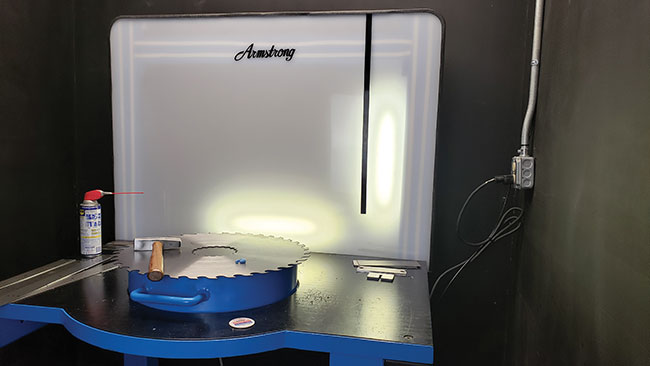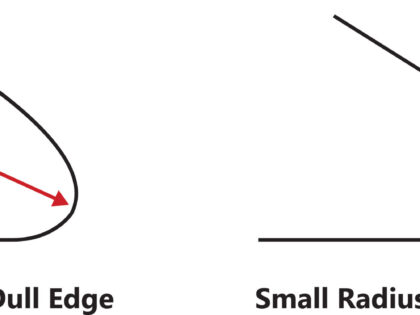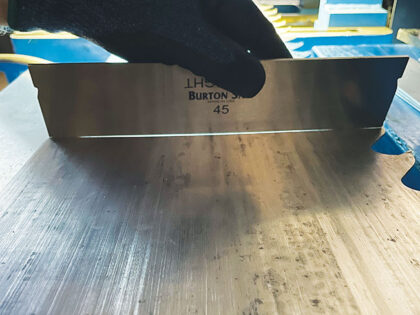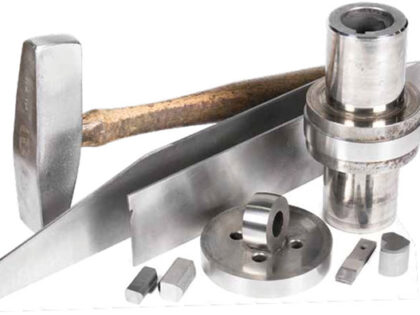
Features
Saw filing: Don’t expect, inspect
May 30, 2023 By Dave Purinton
 Regularly take a critical visual inspection of blades. Photos courtesy of Burton Mill Solutions.
Regularly take a critical visual inspection of blades. Photos courtesy of Burton Mill Solutions. At the Simonds International Tech Center for sawfiler vocational training, we use a number of slogans or phrases to encourage students to remember to focus on the fundamentals. One of those phrases is “Don’t expect, inspect.”
Simply loading a saw blade onto a CNC or conventional sharpening machine and pushing the start button is no guarantee you will produce a sharp, ready-to-run blade. The proper amount of material removal from the top, face, and gullet of each saw tooth is one critical element for an uninterrupted run on the mill. Too little material removal and you will return a dull saw blade to service or one prone to gullet cracks. Remove an excess of material and run the risk of damaging the blade by burning the saw tips or gullet, needlessly high abrasive costs, and premature retipping or swaging.
So how does one quickly check that a saw blade queued up for its next production cycle is properly sharpened for the intended run time? One technique is to regularly take a critical visual inspection of blades classified as ready-to-run. Use a penlight for this quick visual inspection. Check the saws out as if you or your team did not put them up. Inspect it as if you had not already reconditioned it. The cutting edge of a sharp saw blade will not reflect light. If you observe a reflection on the cutting edge of the blade, that is an indication the edge still has a radius or flat on it. To get a feel for this technique, inspect your blades after their run and prior to reconditioning them. This can help the learning with just how much material must be removed from the saw tip to get it sharp enough to properly function on the mill. This is also an opportunity to monitor for material handling abuse. Are those corners intact and sharp?
Another area in the filing room that can lead to unnecessary saw changes or short blade life is the slow and inevitable degradation of wear parts of your tools. Even those fancy CNC and automated blade reconditioning machines have wear parts that require monitoring! At the Simonds International Technical Center, we have learned from many students that maintaining proper maintenance records is too rare. Most of us rely on a decal on our vehicle windshield to remind us when the next oil change is due. Why would we do anything less for the equipment and hand tools in our filing rooms? Maintenance records must be maintained and easily accessible for review when things “don’t go right.”
This activity applies to basic hand tools as well. Saw hammers, straight edges, tension gauges, stretcher roll components, and even leveling blocks are all wear parts. One challenge with maintaining hand tools is that the wear can be very gradual. A filer may even subconsciously adapt to the tool wear – and cause him or herself extra work in the process. Each of these hand tools should be inspected on a recurring basis. And like changing the oil in your vehicles, the inspection dates should be recorded in a log. If one cannot remember the last time the hand tools were inspected, that is likely a good sign the task is overdue. Logbooks are also useful for sharing the inspection frequency with others in the department. One technique for a visual inspection of the tension gauge or straight edge is to observe the light pattern either on a saw blade or levelling block. Then rotate the tool 180 degrees and observe the exact same spot. The look should be identical. If the shape of the light varies, it is time to take the next step and evaluate the tool with your inspection gauge. “Don’t expect, inspect.”
Inspection gauges are not used in daily saw maintenance and not subject to wear. These straight edges and tension gauge tools can be like a friendly port in a storm of frustration in the filing room. Ask yourself: when was the last time you calibrated your dial indicators too? If your saws are not behaving like you “expect,” it may be time to “inspect” the tools and machines you are using to perform the blade reconditioning task and ensure that they are not causing you more work than benefit. Sawfilers who maintain good control of the variables under their control can help prevent even a few unscheduled saw changes.
 Dave Purinton is the vice-president for marketing and the director of Saw Filer Training Center at Burton Mill Solutions.
Dave Purinton is the vice-president for marketing and the director of Saw Filer Training Center at Burton Mill Solutions.
This article is part of CFI’s 2023 File Week. Find the File Week landing page here.
Print this page


